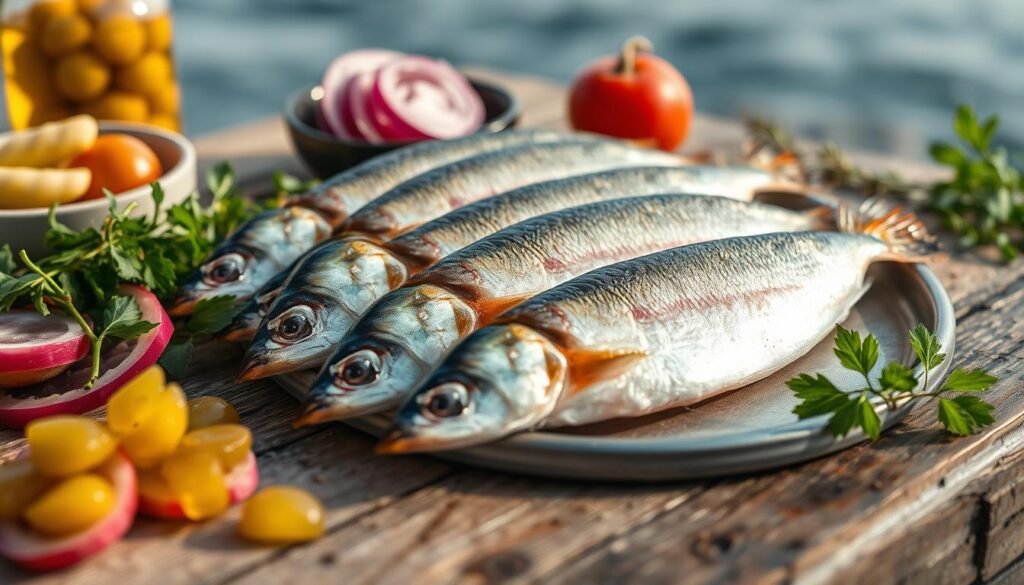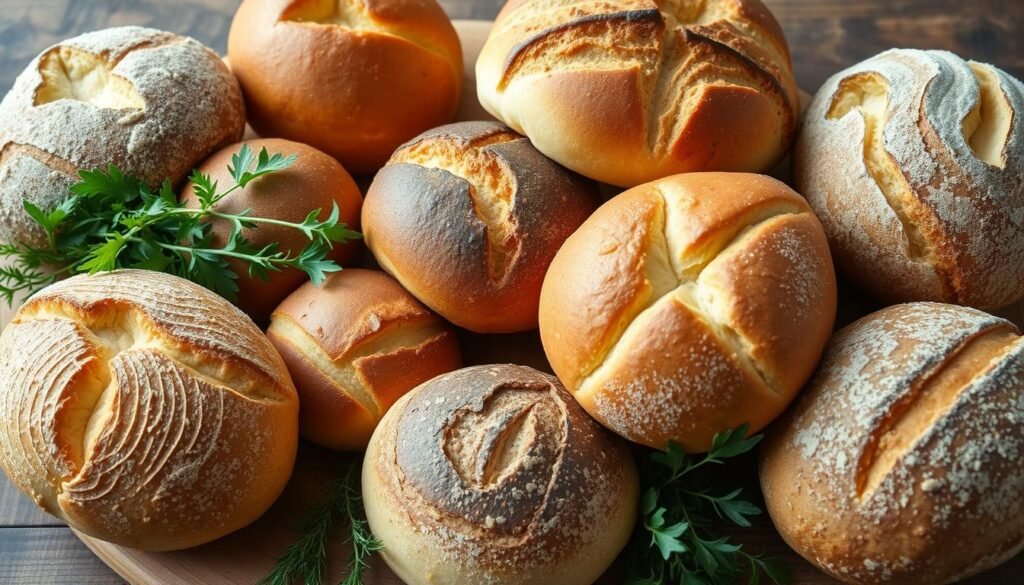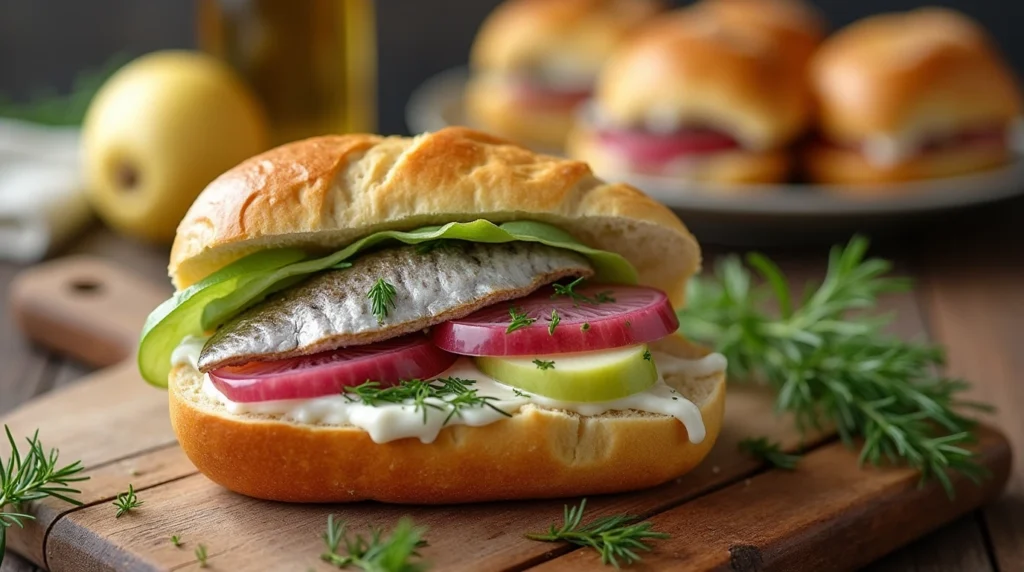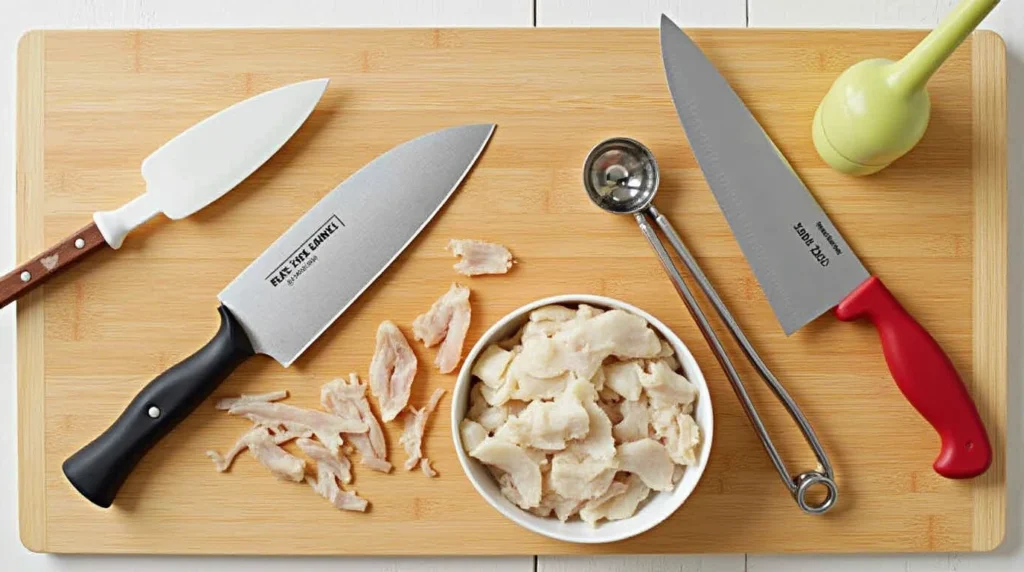Growing up in a small German town, the smell of fresh bread and marinated herring filled the air. It was a sign that the Matjesbrötchen, a beloved seafood sandwich, was ready. This dish has been a family favorite for generations.
Just thinking about it brings back memories of sitting at the kitchen table, waiting for my first bite. As an adult, I’ve wanted to share this tradition with everyone. I want to help others enjoy the rich flavors of Germany’s culinary heritage in their own homes.
Join me as we explore how to make the perfect Matjesbrötchen. It’s a true taste of German tradition.
Table of Contents
Key Takeaways
- Discover the history and cultural significance of the traditional German Matjesbrötchen
- Learn how to source the finest Matjes herring and select the perfect bread rolls
- Master the step-by-step process of preparing the classic Matjesbrötchen recipe
- Explore modern twists and innovative serving suggestions to elevate the dish
- Pair the Matjesbrötchen with complementary beverages and side dishes for a complete culinary experience
Understanding the Traditional German Matjesbrötchen
The Matjesbrötchen is a beloved North Sea delicacy with a rich history. It started as a simple meal for fishermen. Over time, it became a national dish loved across Germany.
History of Matjesbrötchen in German Cuisine
Matjes herring, a tasty North Sea fish, has been key in German food for ages. Since the 17th century, people in coastal areas have enjoyed these preserved herrings on soft bread. It was a way to use the North Sea’s seafood bounty.
Regional Variations and Significance
As Matjesbrötchen grew in popularity, different regions in Germany put their own twist on it. The north uses creamy sauces, while the south adds fresh herbs. This shows the diversity and pride in German cuisine.
Now, the Matjesbrötchen is a cherished part of German food culture. It’s celebrated for its taste and its link to the country’s sea and coastal communities.
Essential Ingredients for Authentic Matjesbrötchen
To make a real Matjesbrötchen, you need top-notch ingredients. You’ll want the best matjes herring, fresh bread rolls, and extras like onions and apples.
The matjes herring is the main attraction. It’s a special type of herring that adds a unique taste. It’s key to the sandwich’s flavor.
The fresh bread rolls are also crucial. They should be soft and strong enough to hold the herring and toppings. Choose from Kaiser rolls or sourdough for the best taste.
Don’t forget to add onions and apples to your Matjesbrötchen. They add a nice crunch and sweetness. This balances the flavors perfectly.
| Ingredient | Purpose |
|---|---|
| Matjes Herring | Provides the savory, distinctive flavor of the Matjesbrötchen |
| Fresh Bread Rolls | Offers a light, fluffy base to support the herring and toppings |
| Onions | Adds crunch and a subtle sweetness to balance the dish |
| Apples | Contributes a crisp texture and complementary sweetness |
With these key ingredients, you’re ready to make a tasty Matjesbrötchen. It will take you straight to the heart of German food.
Selecting the Perfect Matjes Herring
Choosing the right matjes herring is crucial for a great Matjesbrötchen. Matjes herring is a key ingredient in German cuisine. It’s important to know the quality and where to find it.
Fresh vs. Preserved Herring
Fresh or preserved matjes herring depends on what you like and what’s available. Fresh matjes have a soft texture and a buttery taste. Preserved matjes are cured and taste more intense and salty.
Both can be good in your Matjesbrötchen. Think about what you prefer and what you want your sandwich to taste like.
Quality Indicators to Look For
- Bright, glistening appearance with a firm, resilient texture
- Mild, fresh aroma without any fishy or off-putting odors
- Vibrant, uniform coloration, typically a pale yellow or golden hue
- Absence of discoloration, blemishes, or signs of spoilage
Where to Source Matjes Herring
Finding good matjes herring can be hard, especially in the U.S. Look for fresh fish markets or seafood shops that get their fish from Germany or the Netherlands. Online quality seafood stores are also a good choice. Make sure to pick a trusted seller for the best taste.
By picking the right matjes herring, you’ll make a Matjesbrötchen that’s true to German tradition.

Choosing the Right Bread Roll
Choosing the right bread roll is key to making a perfect Matjesbrötchen. German bread rolls, or Brötchen, come in many textures and flavors. These can make your traditional dish even better.
Look for a Brötchen with a crusty outside and a soft inside. This mix of textures is perfect for the Matjes herring and creamy toppings. German bread rolls are the best choice because they are sturdy yet soft.
Try different Brötchen varieties like the Kaiser roll or Vollkornbrötchen. Each type of crusty bread adds its own special touch to the Matjesbrötchen. Find the one that you like best.
| Brötchen Variety | Characteristics | Recommended Use |
|---|---|---|
| Kaiser Roll | Crusty exterior, soft interior | Traditional choice for Matjesbrötchen |
| Vollkornbrötchen | Hearty, nutty flavor, chewy texture | Pairs well with robust herring flavors |
| Sesame Seed Brötchen | Crisp crust, nutty aroma | Adds a delightful crunch to the sandwich |
No matter which Brötchen variety you pick, choose a fresh roll. It’s the base of your Matjesbrötchen masterpiece.

Preparing the Classic Matjesbrötchen Recipe
Making the perfect Matjesbrötchen, a favorite German open-faced sandwich, needs fresh ingredients and old techniques. Let’s explore how to make this traditional treat step by step.
Prepping the Herring
The key to Matjesbrötchen is the Matjes herring, a special type of herring. Start by rinsing it under cold water to get rid of extra brine. Then, carefully remove the flesh from the bones. Cut the fillets into thin pieces for even texture.
Creating the Traditional Sauce
The sauce for Matjesbrötchen is a mix of flavors that goes well with the herring. Mix sour cream, lemon juice, chopped onions, and a bit of salt and pepper in a bowl. This sauce will give your Matjesbrötchen a true German taste.
Assembly Techniques
Now, it’s time to put your Matjesbrötchen together. Toast or grill a soft bread roll lightly. Spread the sauce on the roll, then add the herring slices. Top it with red onions, capers, and a dill sprig for a beautiful and tasty dish.
By following these steps, you can make the classic Matjesbrötchen at home. It captures the essence of German cooking. Enjoy your homemade Matjesbrötchen with loved ones and enjoy the mix of flavors that make it special.

Essential Equipment and Tools
To make the perfect Matjesbrötchen at home, you need the right tools. This includes kitchen utensils, cutting boards, and sharp knives. These tools help you prepare and assemble this traditional German dish efficiently. Let’s look at the must-have equipment for making Matjesbrötchen.
Ideal Cutting Boards and Knives
A good cutting board is key for slicing the Matjes herring and other ingredients. Choose a large, sturdy wooden or plastic board for plenty of space. For knives, a sharp, high-quality kitchen knife is essential. A sharp knife makes slicing the herring and other parts easy.
Essential Utensils
- A paring knife for delicate tasks, such as removing the skin from the herring
- A small bowl scraper to neatly transfer the herring and other ingredients
- A sturdy spoon for mixing the traditional sauce
- A butter knife or small spreader for applying the sauce to the bread rolls
Having the right kitchen utensils makes preparing Matjesbrötchen easier and more fun.
| Essential Equipment | Recommended Features |
|---|---|
| Cutting Board | Large, sturdy wooden or plastic surface |
| Chef’s Knife | High-quality, sharp blade for effortless slicing |
| Paring Knife | Small, precise blade for delicate tasks |
| Bowl Scraper | Flexible tool for neatly transferring ingredients |
| Mixing Spoon | Sturdy spoon for combining sauce ingredients |
| Butter Knife | Small, flat blade for spreading sauce on bread rolls |
With these essential kitchen utensils, cutting board, and sharp knife, you’re ready to make a delicious Matjesbrötchen at home.

Step-by-Step Assembly Process
Making the perfect Matjesbrötchen is all about balance. Start by cutting your bread roll in half, making a top and bottom. Spread creamy sauce on the bottom half, making sure it covers the whole area.
Then, add the Matjes herring on top. Place the herring fillets in a way that they overlap, covering the sauce. Make sure each piece of herring is separate for the best taste and look.
Layering Components
Once the herring is on, add some fresh onions on top. Slice the onions thinly and arrange them nicely. Add some chives or parsley for a burst of freshness and flavor.
Garnishing Tips
- Finish by placing the top bun on the sandwich, pressing it gently.
- Add a sprig of fresh dill or a lemon wedge for a touch of elegance.
- Serve the Matjesbrötchen right away so everyone can enjoy its delicious flavors and textures.
By following these steps, you can make a Matjesbrötchen that truly represents this German favorite.

Common Mistakes to Avoid
Making the perfect Matjesbrötchen needs focus and knowing what to avoid. Steer clear of these mistakes to make sure your homemade Matjesbrötchen are perfect every time.
One big mistake is overcrowding the ingredients. Too many toppings can make the sandwich soggy and unbalanced. Keep the right mix of Matjes herring, creamy sauce, and fresh bread for the best taste and texture.
Also, don’t use stale or subpar bread rolls. The bun’s soft, pillowy texture is key to match the herring’s delicacy. Choose fresh, quality rolls that absorb flavors well without getting soggy.
- Pick the freshest Matjes herring for the best taste.
- Don’t over-mix the sauce to avoid a gloopy mess.
- Be gentle when handling the herring fillets to keep their texture.
By avoiding these matjesbrötchen errors, soggy bread, and overcrowding ingredients, you’ll make the perfect Matjesbrötchen at home.
Storage and Serving Recommendations
Keeping your homemade Matjesbrötchen fresh and tasty is crucial. We’ll look at the best ways to store and serve them. You’ll learn about matjesbrötchen storage, serving temperature, and presentation ideas.
Temperature Considerations
Temperature is important for matjesbrötchen storage. Store the herring, sauce, and bread rolls separately in the fridge. The herring and sauce last up to 3 days. Use the bread rolls within 1-2 days for the best taste.
For the best taste, serve the Matjesbrötchen at room temperature. This lets the flavors shine and the bread feel just right. Don’t serve them cold from the fridge, as it can dull the taste.
Presentation Ideas
- Place the Matjesbrötchen on a wooden board or platter. Add fresh dill and lemon wedges for a nice look.
- Put the herring, sauce, and bread rolls on a platter. Let everyone make their own Matjesbrötchen.
- For a fancy look, serve each Matjesbrötchen on a plate. Arrange the herring and sauce on top of the bread.
| Storage Recommendations | Serving Temperature |
|---|---|
| Herring and sauce: Up to 3 days in the refrigerator Bread rolls: 1-2 days in the refrigerator | Room temperature for optimal flavor and texture |
By following these storage and serving guidelines, and trying out different presentation techniques, you’ll make sure your Matjesbrötchen are enjoyed to the fullest.
Modern Twists on the Classic Recipe
Today, chefs and home cooks are adding their own twist to the classic Matjesbrötchen. They use modern ingredients and fusion ideas. This keeps the dish fresh for the 21st century while staying true to its roots.
The Matjesbrötchen Sushi is a popular modern take. It rolls the herring and toppings into sushi. This mix of German flavors and Japanese style is both tasty and visually appealing.
Another twist is the Matjesbrötchen Tartlets. Here, the herring and toppings are in flaky pastry shells. It’s a fancy way to enjoy the dish, letting the flavors stand out.
Ingredient Substitutions for a Contemporary Flair
Creative cooks are also trying new ingredients in Matjesbrötchen. For example, they might use toasted sourdough or herb-infused flatbread instead of traditional bread.
- Some recipes swap matjes herring for smoked trout or salmon. This adds a fancy touch.
- Adding bold flavors like pickled onions or balsamic glaze makes the dish more complex.
- Using micro-greens or edible flowers can make the dish look even better.
Whether you stick to the classic recipe or try something new, Matjesbrötchen is always a hit. It’s a dish that keeps getting better with time.
Pairing Suggestions and Side Dishes
Enhancing your Matjesbrötchen experience is more than just the right bread and herring. Choosing the right drinks and side dishes can really make the flavors pop. Let’s dive into some tasty pairings to make your Matjesbrötchen feast unforgettable.
Beverage Recommendations
For drinks, German beers are a top pick. A crisp German pilsner or lager complements the Matjesbrötchen’s creamy texture. For something different, try a fruity German wheat beer. It matches the herring’s sweetness nicely.
If you don’t drink alcohol, German lemonade, or Zitronenlimonade, is a great choice. Its tangy taste cuts through the richness of the dish.
Complementary Foods
To complete your Matjesbrötchen meal, add some classic German sides. A crisp side salad with tangy dressing is a refreshing contrast. For something more filling, try creamy potato dishes like Bratkartoffeln or Kartoffelsalat.
| Beverage | Complementary Side Dish |
|---|---|
| German Pilsner or Lager | Side Salad |
| German Wheat Beer | Bratkartoffeln (Pan-Fried Potatoes) |
| Zitronenlimonade (German Lemonade) | Kartoffelsalat (German Potato Salad) |
By choosing the right drinks and sides, you can make your Matjesbrötchen meal a true German culinary delight.
Conclusion
Creating the perfect homemade Matjesbrötchen is a journey into Germany’s culinary heart. This seafood sandwich is a celebration of quality ingredients and traditional methods. By mastering this recipe, you’ve not only added a tasty dish to your repertoire but also connected with a rich cultural heritage.
Whether you stick to the classic recipe or try new twists, the secret to success is in the details. Choosing the freshest Matjes herring and making the right accompaniments are key. These steps ensure the flavors and textures come together beautifully. With the tips from this article, you can make your homemade Matjesbrötchen truly special, enjoying the pride of creating a German culinary gem in your kitchen.
As you explore more about homemade Matjesbrötchen, remember to appreciate its history and regional flavors. This dish is a big part of German food culture. By embracing the art of making seafood sandwiches, you pay tribute to the tradition and passion that have kept it alive for centuries. This way, you ensure that the flavors of Germany’s past continue to excite and inspire food lovers like you for many years.
FAQ
What is a Matjesbrötchen?
A Matjesbrötchen is a traditional German seafood sandwich. It’s made with marinated herring, fresh bread rolls, and other ingredients.
What are the key ingredients in a Matjesbrötchen?
The main ingredients are high-quality matjes herring, fresh bread rolls, onions, apples, and a special sauce.
How do I select the best matjes herring for my Matjesbrötchen?
Choose fresh, high-quality matjes herring. It should have a firm texture and bright appearance. Avoid dry or discolored herring. Get it from reputable fish markets or specialty seafood stores.
What type of bread rolls are best for Matjesbrötchen?
Use German Brötchen for the best results. They have a crisp outside and soft inside. Look for denser rolls that can hold the herring and sauce.
How do I prepare the traditional matjes herring sauce?
The classic sauce mixes sour cream, mayonnaise, vinegar, and seasonings like dill and mustard. It balances the herring’s richness and adds a tangy creaminess.
What are some common mistakes to avoid when making Matjesbrötchen?
Avoid stale or soggy bread and overcrowding the sandwich. Don’t forget to marinate the herring properly. Assemble the sandwiches just before serving to keep them fresh.
How should I store and serve Matjesbrötchen?
Store the herring, sauce, and bread separately. Assemble the sandwiches just before serving. Serve at room temperature or slightly chilled. Add fresh herbs or lemon wedges for a nice touch.
Can I make modern variations of the traditional Matjesbrötchen?
Yes! You can try new twists like different herring types, vegetable fillings, or unique sauces and toppings.



